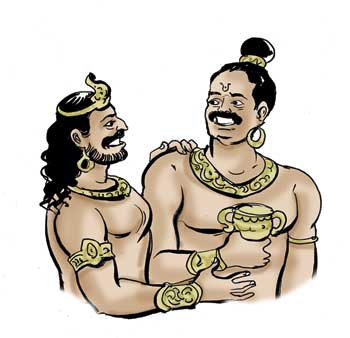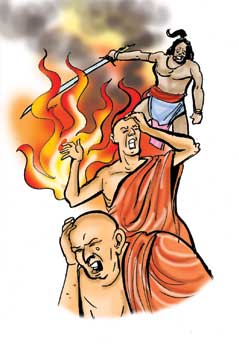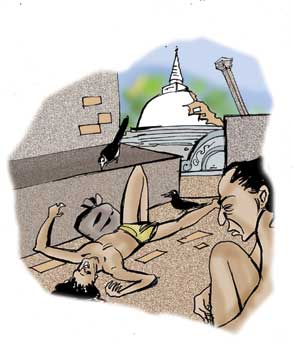
The Chiefs Flee~This article is part of a continuing series on the ‘Mahavamsa,’ the recorded chronicle of Sri Lankan history~
2. Because of all this suffering, the chiefs gave up their lands and fled. They fled to the North East, the Mayarata and to Ruhuna. At this time, the irrigation system was maintained by these chiefs. Once they fled, the entire system collapsed. This was further weakened because some of the villagers too fled along with them. The few who remained, did not have a leader under whom they could work, repair and maintain the system. This finally resulted in the decline of agriculture. 3. The helpless villagers, who did not have the security of their leaders, fled in due course. The Kerala soldiers robbed them of everything, including the clothes they wore. Magha's cruelty was most felt in the field of Buddhism. The Kerala soldiers ruined most of the dagabas, image-houses and occupied the temples. The devotees and their children were beaten. The books which were on 'ola-leaf' and bound together were all scattered here and there.
5. The people who were assigned different duties in connection with the maintenance of these religious places, had been performing their duties, generation after generation. But they too were forced to leave their villages. They accompanied the Buddhist priests. The cruelty of Magha was not confined to Buddhists only. Even Tamil Hindus who associated them closely, were made to suffer. 6. According to certain scholars, Magha belonged to a Hindu sect (Nikaya) called 'Veera-Shaiva,' who were intolerant of other faiths. They had been cruel to the followers of the 'Vaishnava' faith and all other Hindu followers. This was a period, when in areas like Polonnaruwa and Kantalai, there were 'Vaishnava' followers, who lived alongside the Sinhalese people. They lived in friendship and harmony.
8. Some Sinhala and Tamil people who fled settled in close proximity to the harbours of Mannar and Trincomalee. They had to give up their cultivation and take to fishing. Meanwhile, some of them, went to South India to carry on trade. However, ten to twenty years after the arrival of Magha, the dry zone was completely deserted. |
|
||||||
|| Front
Page | News | Editorial | Columns | Sports | Plus | Financial
Times | International | Mirror | TV
Times | Funday
Times || |
| |
Reproduction of articles permitted when used without any alterations to contents and a link to the source page.
|
© Copyright
2008 | Wijeya
Newspapers Ltd.Colombo. Sri Lanka. All Rights Reserved. |
 1. By the time Kalinga Magha conquered Polonnaruwa, the chiefs had distanced themselves from the royal palace. They hated Magha and worked against him. Hence Magha too hated them in return. He was determined to follow a harsh policy towards them. Kerala soldiers were employed to harass them and plunder their wealth. They ruined the respect of the noble families. Wives and children were harassed and shame and dishonour brought upon them.
1. By the time Kalinga Magha conquered Polonnaruwa, the chiefs had distanced themselves from the royal palace. They hated Magha and worked against him. Hence Magha too hated them in return. He was determined to follow a harsh policy towards them. Kerala soldiers were employed to harass them and plunder their wealth. They ruined the respect of the noble families. Wives and children were harassed and shame and dishonour brought upon them. 4. The dagabas like Ruwanweliseya, which received the veneration of even the kings, were destroyed. The treasury was plundered. The relics that were enshrined began to disappear. Temples, pirivenas and devales were made their dwelling places. This resulted in the Buddhist monks leaving the Rajarata. It is not only the priests of Polonnaruwa, but all others who lived even in distant villages also left. The drift was towards the North-East, Malayrata and the South.
4. The dagabas like Ruwanweliseya, which received the veneration of even the kings, were destroyed. The treasury was plundered. The relics that were enshrined began to disappear. Temples, pirivenas and devales were made their dwelling places. This resulted in the Buddhist monks leaving the Rajarata. It is not only the priests of Polonnaruwa, but all others who lived even in distant villages also left. The drift was towards the North-East, Malayrata and the South. 7. Due to the suffering they underwent under Magha, they too would have fled along with the Sinhala people. Almost the entire land in the dry zone was abandoned and the ministers and all other village leaders left their villages. Some who were terrified of Magha, went into the jungle and made their living there. These were the villages which later came to be known as 'Vanni gam.' After some time, leaders were appointed for these villages and they were known as the leaders of 'Vanni.'
7. Due to the suffering they underwent under Magha, they too would have fled along with the Sinhala people. Almost the entire land in the dry zone was abandoned and the ministers and all other village leaders left their villages. Some who were terrified of Magha, went into the jungle and made their living there. These were the villages which later came to be known as 'Vanni gam.' After some time, leaders were appointed for these villages and they were known as the leaders of 'Vanni.'